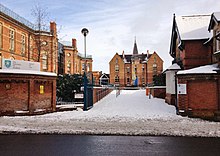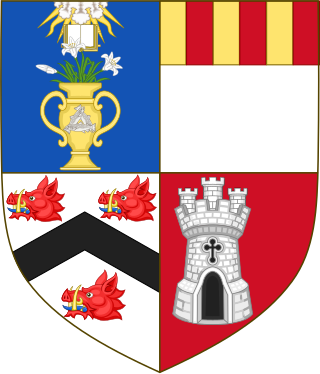
The University of Birmingham is a public research university in Birmingham, England. It received its royal charter in 1900 as a successor to Queen's College, Birmingham, and Mason Science College, making it the first English civic or 'red brick' university to receive its own royal charter, and the first English unitary university. It is a founding member of both the Russell Group of British research universities and the international network of research universities, Universitas 21.
Wellington College, is a state-run boys secondary school in Wellington, New Zealand. It is situated on 12 hectares of green belt land in the suburb of Mount Victoria, in the vicinity of the Basin Reserve and Government House. The school was founded in 1867 through a deed of endowment from Sir George Grey, the then Governor of New Zealand.

The University of Sheffield is a public research university in Sheffield, South Yorkshire, England. Its history traces back to the foundation of Sheffield Medical School in 1828, Firth College in 1879 and Sheffield Technical School in 1884. University College of Sheffield was subsequently formed by the amalgamation of the three institutions in 1897 and was granted a royal charter as University of Sheffield in 1905 by King Edward VII.
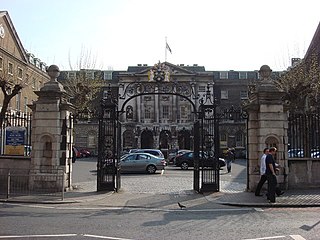
Guy's Hospital is an NHS hospital in the borough of Southwark in central London. It is part of Guy's and St Thomas' NHS Foundation Trust and one of the institutions that comprise the King's Health Partners, an academic health science centre.
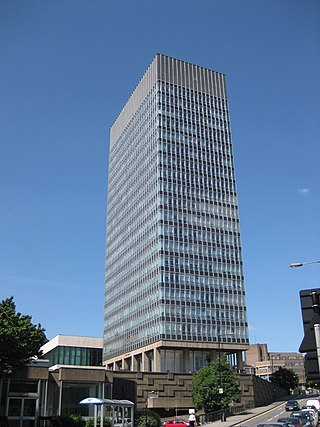
The Arts Tower is a building at 12 Bolsover Street in Sheffield, England, belonging to the University of Sheffield and which opened in 1965. A spokesperson for English Heritage described it as "the most elegant university tower block in Britain of its period". At 78 m (256 ft) tall, it is the second-tallest building in the city, after the 101 m (331 ft) St Paul's Tower on Arundel Gate, which was topped out in 2009. Mitchell Construction a British civil engineering firm, built the Arts Tower. Photographs from their topping out ceremony in October 1964 help to document a different era in UK working conditions.

The Main Building of University College London, facing onto Gower Street, Bloomsbury, includes the Octagon, Quad, Cloisters, Main Library, Flaxman Gallery and the Wilkins Building. The North Wing, South Wing, Chadwick Building and Pearson Building are also considered part of the main UCL building.

The Alfred Denny Building is a 7-storey red brick building in Sheffield, England named after the first Professor of Zoology at the department. It is part of the Western Bank Campus of the University of Sheffield, linked to Firth Court via the Addison Building.

Firth Court is a Grade II listed Edwardian red-brick building that forms part of the Western Bank Campus of the University of Sheffield in the United Kingdom. Located on the northern side of Western Bank, it is the main administrative centre for the university and also houses the Departments of Molecular Biology and Biotechnology and Biomedical Science.

The Octagon Centre, built in 1983, is a multi-purpose conference centre and music venue at the University of Sheffield, England. Situated in the Western Bank campus, it is joined by a skyway to University House and comprises an eight-sided auditorium with a capacity of 1,500, offices, meeting rooms, and a lounge with bar and patio.

The Northern General Hospital is a large teaching hospital and Major Trauma Centre in Sheffield, England. Its departments include Accident and Emergency for adults, with children being treated at the Sheffield Children's Hospital on Western Bank. The hospital is managed by the Sheffield Teaching Hospitals NHS Foundation Trust.

University House is a large 6 floor building in the centre of the University of Sheffield's campus.
The Melbourne City campus of the Royal Melbourne Institute of Technology is located in the city centre of Melbourne in Victoria, Australia. It is sometimes referred to as "RMIT City" and the "RMIT Quarter" of the city in the media.
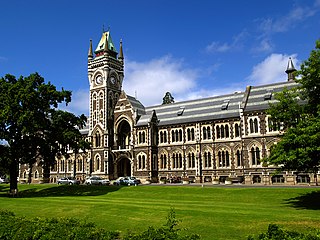
The University of Otago Clocktower complex is a group of architecturally and historically significant buildings in the center of the University of Otago campus. Founded in Dunedin, New Zealand, in 1869, the University of Otago was the expression of the province's Scottish founders' commitment to higher education. They were also the inheritors of a strong architectural tradition and gritty determination. Defending the decision to build inexpensive materials in an elaborate historicizing manner the Chancellor, Dr. D.M. Stuart, said "the Council had some old-world notions and liked to have a university with some architectural style". This attitude persisted for over fifty years and resulted in an impressive group of buildings.

The University of Wales Trinity Saint David is a multi-campus university with three main campuses in South West Wales, in Carmarthen, Lampeter and Swansea, a fourth campus in London, England, and learning centres in Cardiff, Wales, and Birmingham, England.

Central Campus is the primary academic and administrative section of Cornell University's Ithaca, New York campus. It is bounded by Libe Slope on the west, Fall Creek on the north, and Cascadilla Creek on the South.
The 1950s and 1960s saw the construction of numerous brutalist apartment blocks in Sheffield, England. The Sheffield City Council had been clearing inner-city residential slums since the early 1900s. Prior to the 1950s these slums were replaced with low-rise council housing, mostly constructed in new estates on the edge of the city. By the mid-1950s the establishment of a green belt had led to a shortage of available land on the edges of the city, whilst the government increased subsidies for the construction of high-rise apartment towers on former slum land, so the council began to construct high-rise inner city estates, adopting modernist designs and industrialised construction techniques, culminating in the construction of the award-winning Gleadless Valley and Park Hill estates.

Western Bank Library is a library at the University of Sheffield located on Western Bank, forming part of the Western Bank Campus. Formerly the Main Library, it is a Grade II* listed building opened in 1959 by Nobel prize-winning poet T. S. Eliot. The library was designed and built as a result of a national competition announced by the university in 1953. It was the university's main library until the Information Commons was opened in April 2007. Western Bank Library is linked to the Arts Tower via a bridge between their mezzanine floors. The two buildings are intended to be viewed together according to their architect Gollins Melvin Ward.

Jessop West is a building in Sheffield, South Yorkshire, and is part of the University of Sheffield. Designed by Berlin-based architectural firm Sauerbruch Hutton, it was completed in 2009, and is on the corner of Leafygreave Road and Upper Hanover Street, opposite the Information Commons.


